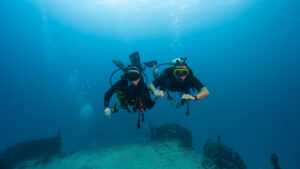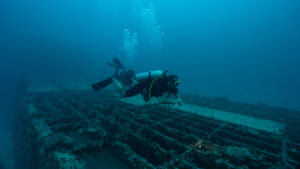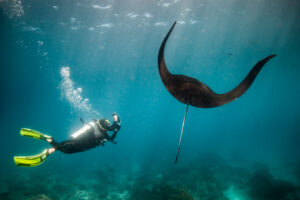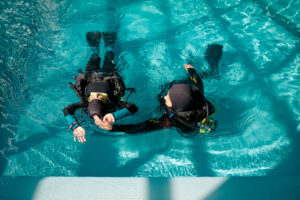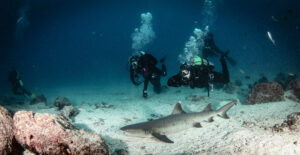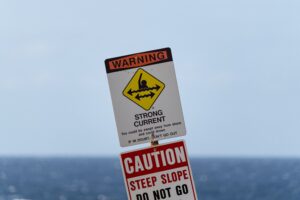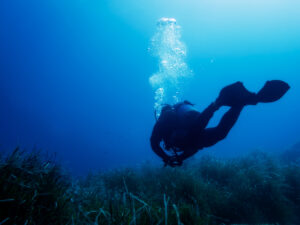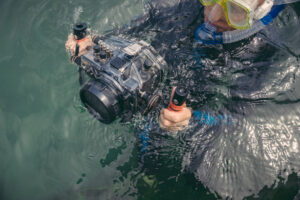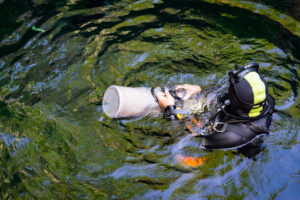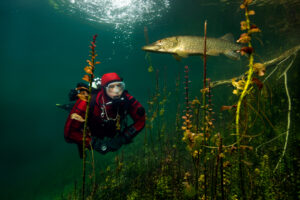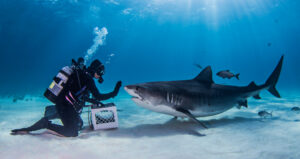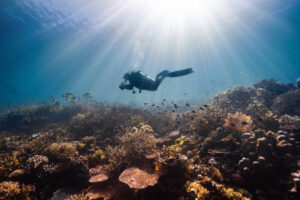What is Absolute Pressure in Scuba Diving Context?
Absolute pressure, a term frequently used in the field of scuba diving, refers to the total static pressure at a particular point. It is a vital concept that divers need to understand and appreciate to ensure safety during their underwater adventures. In technical terms, absolute pressure is the sum of the atmospheric pressure and the pressure due to any fluid column above the point of measurement. It is always measured relative to a perfect vacuum, which is devoid of all matter and hence bears a pressure of zero.
Understanding Pressure in Diving Context
When we talk about pressure in the context of scuba diving, it is necessary to understand it from both a scientific and practical perspective. From the scientific standpoint, pressure is force exerted per unit area, and in the underwater environment, this force is predominantly due to the weight of the water column above.
The practical aspect of understanding pressure revolves around its impacts on the human body and how to manage those impacts during a dive. As one descends in water, the pressure increases, affecting various physiological aspects such as lung volume, equalization, and potential for decompression sickness.
The Components of Absolute Pressure
Atmospheric Pressure
Atmospheric pressure is the first component of absolute pressure. It is the force exerted by the weight of the atmosphere and is equivalent to approximately 1 bar or 14.7 psi at sea level.
The relationship between atmospheric pressure and altitude is inversely proportional; as altitude increases, atmospheric pressure decreases. This principle is crucial for divers to understand, especially when planning dives at higher altitudes or dives that involve a significant change in altitude post-dive (such as flying).
Hydrostatic Pressure
Hydrostatic pressure is the second key component of absolute pressure in the context of diving. It is the pressure exerted by a fluid due to the force of gravity. In simpler terms, it is the pressure you feel from the water above you when you are underwater.
For every 10 meters of water depth, the pressure increases by approximately 1 bar (or 14.7 psi). This increase is due to the weight of the water column above the diver. As a diver descends, the increasing hydrostatic pressure has a direct impact on their body and equipment.
Implications of Absolute Pressure in Scuba Diving
Physiological Implications
The human body is designed to live at 1 bar of pressure (at sea level). When we dive, the increased pressure affects our bodies in several ways, from the volume of our lungs to the nitrogen absorption in our tissues.
As the pressure increases with depth, the volume of gas spaces in our body, such as the lungs, decreases due to Boyle’s law. This principle necessitates the need for divers to breathe pressurized air to counter the external pressure and maintain lung volume.
Another significant implication of increased pressure is the increased rate of nitrogen absorption by our tissues, leading to potential for decompression sickness (DCS), a dangerous condition that can occur if a diver ascends too quickly.
Equipment Implications
Absolute pressure also has direct implications on scuba diving equipment. The increased pressure at depth affects the volume of air in the scuba tank and the diver’s buoyancy.
As a diver descends, the air in the scuba tank and buoyancy compensator device (BCD) is compressed due to the increasing pressure, decreasing its volume. This means that at depth, a diver consumes air more quickly than at the surface, and the BCD requires more air to maintain neutral buoyancy.
Managing Absolute Pressure in Scuba Diving
Depth and Pressure Management
Managing absolute pressure in scuba diving primarily involves understanding and controlling your depth. The deeper you go, the greater the absolute pressure, with potential implications for both physiology and equipment.
One vital tool for managing depth is the dive computer or depth gauge, which allows divers to monitor their current depth accurately. By staying within planned depth limits, divers can manage the risks associated with increased pressure, including decompression sickness and oxygen toxicity.
In addition, divers must be aware of the rate at which they descend and ascend. Rapid changes in depth can lead to problems with equalization and an increased risk of barotrauma. Therefore, a controlled, slow ascent is essential, particularly the last 5-10 meters of ascent, when the most significant pressure changes occur.
Gas Management
Another critical aspect of managing absolute pressure in diving is gas management. As a diver descends and the absolute pressure increases, the density of the breathing gas also increases
, leading to increased air consumption. Therefore, monitoring and managing air supply is crucial, especially during deep dives.
Divers can use their submersible pressure gauge (SPG) to keep track of the amount of air remaining in their tanks. A keen awareness of one’s air consumption rate, which can change with depth, exertion, and even stress, is also vital.
Furthermore, divers must understand the concept of ‘reserve air.’ This is a safety measure that ensures there is enough air left in the tank to safely ascend to the surface and handle any potential emergencies.
The Role of Training and Experience
While understanding the theory of absolute pressure is crucial, applying this knowledge in the real-world context of scuba diving comes with experience and training.
The Role of Training
Training under the supervision of certified professionals provides the opportunity to understand and experience the effects of absolute pressure in a controlled environment. It includes learning about critical safety procedures, such as equalization techniques, ascension rates, and emergency procedures.
Courses offered by scuba diving agencies cover these principles in their entry-level courses and continue to expand on them in advanced and technical diving courses. The emphasis is on promoting a clear understanding of these concepts, encouraging their practical application, and enhancing divers’ ability to manage and respond to situations effectively.
The Role of Experience
While training provides the foundation, experience plays a crucial role in truly understanding and managing absolute pressure in scuba diving. Each dive offers divers an opportunity to apply their knowledge, improve their skills, and gain a deeper understanding of how pressure changes affect them personally.
Experienced divers often develop a better awareness of their bodies, are more adept at managing their equipment under varying pressures, and are more proficient at recognizing and responding to potential problems. This experience, coupled with continuous learning and adherence to safe diving practices, is invaluable in navigating the underwater world safely and confidently.
In the realm of scuba diving, the concept of absolute pressure is a constant companion. From the moment a diver begins their descent to the point they break the surface, understanding and managing pressure is an integral part of the journey. By appreciating this essential principle, divers can ensure that each dive is not only an adventure but also a safe return to the world above.
Absolute Pressure and Diving Environments
Scuba diving can take place in a variety of environments, each with unique considerations when it comes to absolute pressure. Whether diving in the open ocean, freshwater lakes, or altitude, understanding how these environments affect pressure is crucial.
Saltwater vs. Freshwater
The medium in which diving takes place can affect the pressure experienced by a diver. Saltwater is denser than freshwater due to the dissolved salts. This means that a diver in saltwater will experience slightly more pressure at a given depth compared to freshwater.
It’s crucial for divers to understand this difference, especially when calculating dive profiles or determining decompression stops. Failure to account for this can result in inaccurate calculations, which can increase the risk of decompression sickness.
Altitude Diving
Diving at altitude (above sea level) presents another unique consideration for absolute pressure. As the altitude increases, the atmospheric pressure decreases. This means that the total absolute pressure at a given depth in a high-altitude lake will be less than at the same depth in the ocean.
Altitude diving requires special training and considerations, including adjusted no-decompression limits and surface intervals. Dive tables designed for sea level use are not accurate at altitude, and special altitude dive tables or dive computers that account for the reduced atmospheric pressure are necessary.
Advanced Concepts of Absolute Pressure
Pressure Groups
The concept of “pressure groups” is an advanced aspect of absolute pressure in scuba diving. Divers use pressure groups to track nitrogen absorption in their bodies during a dive, allowing them to manage their no-decompression limits and plan safe multi-level or repetitive dives.
Pressure groups are represented by letters, with each letter corresponding to a certain amount of residual nitrogen in the body. These groups help divers determine necessary surface intervals and safety stops to off-gas accumulated nitrogen safely and avoid decompression sickness.
Technical Diving and Mixed Gases
In the realm of technical diving, understanding absolute pressure becomes even more critical. Technical divers often use mixed gases, such as trimix or heliox, which contain different proportions of oxygen, nitrogen, and helium. These mixtures allow divers to go deeper while managing the risks of nitrogen narcosis and oxygen toxicity.
Understanding how these gases behave under increased pressure, and how to calculate their partial pressures, is crucial for planning and executing technical dives safely. This aspect of diving requires advanced training and a thorough understanding of gas laws and their applications in diving.
The concept of absolute pressure is woven into the fabric of scuba diving. From the moment a diver takes their first breath underwater to the planning of complex technical dives, the understanding and management of pressure is of paramount importance. This understanding allows divers to explore the underwater world while ensuring their safety, making every dive an exciting adventure in the fascinating world beneath the waves.
The Future of Understanding Absolute Pressure in Diving
As the sport of scuba diving continues to evolve, so too does our understanding and management of absolute pressure. Advancements in technology, training methodologies, and scientific understanding are continually pushing the boundaries and enhancing the safety and accessibility of diving.
Technological Advancements
Recent years have seen considerable advancements in dive technology that help divers manage absolute pressure more effectively. Modern dive computers, for example, are increasingly sophisticated, offering real-time tracking of depth, dive time, and no-decompression limits. They often incorporate algorithms that consider multiple factors, such as temperature, ascent rate, and even the diver’s breathing rate, to provide more accurate and personalized information.
Further advancements are also being made in the realm of rebreather technology. These systems recycle exhaled gas, removing carbon dioxide and adding the necessary oxygen. They allow divers to maintain an optimal gas mixture (and therefore pressure) at any depth, offering significant benefits for deep and technical diving.
Enhanced Training Programs
Training programs continue to evolve, incorporating new research and technologies to enhance diver understanding of absolute pressure. Traditional classroom learning is increasingly supplemented with online resources, virtual reality simulations, and practical training in controlled environments.
In addition, there is an increasing emphasis on scenario-based training and decision-making skills, helping divers to apply their theoretical knowledge of pressure in practical, real-world situations. This approach fosters a deeper understanding of the implications of absolute pressure, building confidence and competence in managing pressure-related challenges.
Ongoing Research
Ongoing scientific research continues to expand our understanding of how increased pressure affects the human body and how best to manage these effects. Studies are exploring areas such as decompression theory, the effects of different gas mixtures, and individual variability in decompression sickness risk.
This research is informing updates to dive tables, decompression algorithms, and best practice guidelines, helping to enhance the safety and enjoyment of diving for all. It serves as a reminder that our understanding of absolute pressure, like the underwater world itself, is continually deepening.
In the captivating world of scuba diving, absolute pressure is much more than a scientific concept. It’s a fundamental principle that shapes every dive and every diver’s experience. As our understanding and management of pressure continue to evolve, so too does our ability to explore the underwater world safely, responsibly, and with ever-increasing enjoyment. The journey of understanding absolute pressure, like diving itself, is one of continual discovery and awe.


